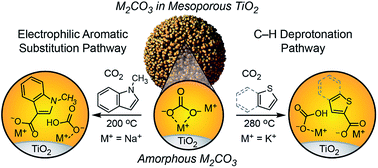Carbonate-promoted C–H carboxylation of electron-rich heteroarenes†
Abstract
C–H carboxylation is an attractive transformation for both streamlining synthesis and valorizing CO2. The high bond strength and very low acidity of most C–H bonds, as well as the low reactivity of CO2, present fundamental challenges for this chemistry. Conventional methods for carboxylation of electron-rich heteroarenes require very strong organic bases to effect C–H deprotonation. Here we show that alkali carbonates (M2CO3) dispersed in mesoporous TiO2 supports (M2CO3/TiO2) effect CO32−-promoted C–H carboxylation of thiophene- and indole-based heteroarenes in gas–solid reactions at 200–320 °C. M2CO3/TiO2 materials are strong bases in this temperature regime, which enables deprotonation of very weakly acidic bonds in these substrates to generate reactive carbanions. In addition, we show that M2CO3/TiO2 enables C3 carboxylation of indole substrates via an apparent electrophilic aromatic substitution mechanism. No carboxylations take place when M2CO3/TiO2 is replaced with un-supported M2CO3, demonstrating the critical role of carbonate dispersion and disruption of the M2CO3 lattice. After carboxylation, treatment of the support-bound carboxylate products with dimethyl carbonate affords isolable esters and the M2CO3/TiO2 material can be regenerated upon heating under vacuum. Our results provide the basis for a closed cycle for the esterification of heteroarenes with CO2 and dimethyl carbonate.



 Please wait while we load your content...
Please wait while we load your content...